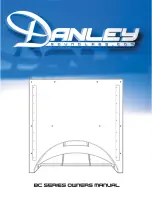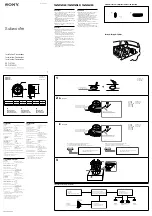
Klein + Hummel
O 810 / O 870 Operating Manual Page 10 of 96
Version 01
Output Card
Output Card
Output Card
Output Card
The output card has seven channels of 4
th
order 80 Hz high pass filtering, and a volume control for each of these
channels. Following this, there are 7 x XLR electronic
7 x XLR electronic
7 x XLR electronic
7 x XLR electronic----balanced output stages
balanced output stages
balanced output stages
balanced output stages. All outputs (main channels and
sum) have protection to avoid power on/off noises: the outputs turn on after a short delay when mains power is
applied and mute instantaneously when the mains power is removed. The content of each output channel
depends on the content placed on each of analog inputs, or the optional digital input’s two subframes (channels).
There is also 80 Hz high pass filtering and summing of the LFE channel to the left and right outputs (more details
of how this is used can be found in the Filter Card section).
Finally, there is a Sum
Sum
Sum
Sum output socket for connecting additional subwoofers into the system. There is no volume
control on this output as volume control is performed locally in each subwoofer. As the output is a filtered sum of
the input channels, it should be connected to the LFE/Sum input on subsequent subwoofers in the system (see
example system diagrams in the System Use section). These should have their LFE mode switch set to “SUB ONLY
(WIDE)” so that double filtering is not applied. As the Sum output is always analog, subwoofers after the first
one in a daisy chain should not have the optional DIM 4 digital input card fitted.
Filter Card
Filter Card
Filter Card
Filter Card
The filter card contains bass management processing, subwoofer filtering, acoustical controls and a remote
control input socket:
The Power On
Power On
Power On
Power On light (red) is illuminated when power is applied to the subwoofer, the mains power switch is on,
and the 12 V DC remote control are in a state to turn on the subwoofer. This light blinks during the power-up
phase of the internal microcontroller, and flashes if the protection system is activated. If the latter happens, turn
down the input signal, use a bigger subwoofer, or add additional subwoofer(s) to the system.
The Bass Management
Bass Management
Bass Management
Bass Management light (green) is illuminated when bass management is on.
The Bass Management
Bass Management
Bass Management
Bass Management switch turns on the bass management. This inserts a 4
th
order 80 Hz high pass filter into
the signal path of each main channel output and routes content below 80 Hz to the subwoofer. Reproduction of
the LFE channel is unaffected by the setting of this bass management switch.
The Rear Channel Bass Management
Rear Channel Bass Management
Rear Channel Bass Management
Rear Channel Bass Management switch define whether the rear channels (left surround, right surround, left
back and right back) are included in the bass management processing. Some sound engineers prefer to bass
manage the rear channels, others do not. The use of this switch avoids having to unplug the XLR connectors for
these channels. Reproduction of the LFE channel is unaffected by the setting of this bass management switch.
The Volume Control
Volume Control
Volume Control
Volume Control switch defines whether the remote volume control facility is activated or not. There is no
attenuation of the input signals when the remote volume control is deactivated, so care should be taken when
adjusting this switch. If a remote control device (SRC 1, SRC 2, or RS-232) is disconnected from the subwoofer,
remote volume control is automatically disabled (gain through the bass management defaults to 0 dB).
The Signal Generator
Signal Generator
Signal Generator
Signal Generator switch applies an 80 Hz sine wave signal to the left channel input (on the DIM 4 it is digital
input 1, subframe A). This low frequency tone will be audible through the subwoofer and the loudspeaker
connected to the left output socket. It is used for setting the phase control (see Calibrating Phase section).
The Subwoofer Gain
Subwoofer Gain
Subwoofer Gain
Subwoofer Gain, Subwoofer Phase
Subwoofer Phase
Subwoofer Phase
Subwoofer Phase, Parametric Equalizer
Parametric Equalizer
Parametric Equalizer
Parametric Equalizer, and Low Cut
Low Cut
Low Cut
Low Cut controls are described in the Acoustical
Controls section below.
LFE channel reproduction depends on the LFE mode
LFE mode
LFE mode
LFE mode settings (see LFE Mode description below) and is unaffected
by the setting of either of the bass management switches.
The LFE Gain
LFE Gain
LFE Gain
LFE Gain switch applies 0 or +10 dB gain to the LFE channel. For Dolby Digital and DTS formats only, one 10
dB boost is required in the monitoring system somewhere between the LFE channel fader on the mixing console
and the listener’s ear. This boost can be performed in the monitoring matrix (console or external), in a decoder
output stage (surround sound processor or DVD/Blue-ray disk player), or in the 7.1 High Definition Bass
Management System™. Before using this switch, check that it has not been applied somewhere else in the signal
path. Too much LFE channel gain results in less LFE channel level in the mix, and vice versa.











































